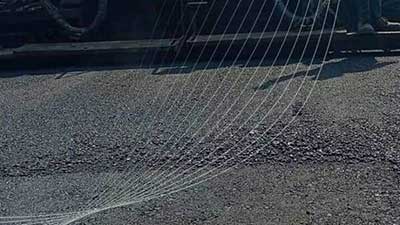Relevance: GS-3: Science and Technology- developments and their applications and effects in everyday life. Conservation, environmental pollution and degradation, environmental impact assessment.
Key phrases: sustainable development, steel waste, ArcelorMittal Nippon Steel India, CSIR India, 1000% processed steel slag, Rail Ballast, Road & pavement material, brick manufacture, PH of the waste water, abrasive materials properties.
Why in News?
- The unique road has come up in the city of Surat in Gujarat at the Hazira Industrial Area. The road has been built with 1000% processed steel slag.
Context:
- In one of the finest examples of sustainable development, Gujarat's Surat has got a road that is made up of steel waste.
- The steel slag road has been built by ArcelorMittal Nippon Steel India with CSIR India (Council of Scientific and Industrial Research) and the Central Road Research Institute (CRRI) and government think tank Niti Aayog.
-
Steel slag, a by-product of steel making, is produced during the separation of the molten steel from impurities in steel-making furnaces. The slag occurs as a molten liquid melt and is a complex solution of silicates and oxides that solidifies upon cooling.
-
There are many grades of steel that can be produced, and the properties of the steel slag can change significantly with each grade. Grades of steel can be classified as high, medium, and low, depending on the carbon content of the steel. High-grade steels have high carbon content. To reduce the amount of carbon in the steel, greater oxygen levels are required in the steel-making process. This also requires the addition of increased levels of lime and dolime (flux) for the removal of impurities from the steel and increased slag formation.
-
There are several different types of steel slag produced during the steel-making process. These different types are referred to as furnace or tap slag, raker slag, synthetic or ladle slags, and pit or cleanout slag.
-
The steel slag produced during the primary stage of steel production is referred to as furnace slag or tap slag. This is the major source of steel slag aggregate. After being tapped from the furnace, the molten steel is transferred in a ladle for further refining to remove additional impurities still contained within the steel. This operation is called ladle refining because it is completed within the transfer ladle.
-
During ladle refining, additional steel slags are generated by again adding fluxes to the ladle to melt. These slags are combined with any carryover of furnace slag and assist in absorbing deoxidation products (inclusions), heat insulation, and protection of ladle refractories. The steel slags produced at this stage of steel making are generally referred to as raker and ladle slags.
Fact about Gujarat's steel road:
- The unique road has come up in the city of Surat in Gujarat at the Hazira Industrial Area.
- The road has been built with 1000% processed steel slag. Steel slag is a major concern for steel industries as it is considered a waste material. The disposal of metallurgical and metal-processing waste in landfills is particularly hazardous for the environment. Processed steel slag aggregate exhibits great potential as a replacement for natural construction material.
- The experimented project is a 1 KM long road and has six lanes.
- The thickness of the road has also been reduced by 30%
- So far the road has proven to be a strong one. More than 1,000 trucks, 18 to 30 every day are passing with tons of weight on the steel road.
Other Utilization of steel slag:
- Rail Ballast: Steel slag is hard, dense and resistant to both attrition and abrasion making it suitable for use as a railway ballast aggregate.
- Road & pavement material: SMS Slag has already been successfully used as road making aggregate in SAIL. Slag mixed with fly ash has been success- fully tried and being used for brick manufacture, Streets, airport runways etc.
- Crushed Steel slag of size approx. 300 mesh sizes can be used for soil conditioning. Tea and coffee plantations are potential customers.
- Steel slag contains oxide of aluminium and iron combined with a calcium base which reacts to neutralize the PH of the waste water.
- Steel slags have been successfully used for flooring tiles because of their good abrasive materials properties.

Way forward:
- Every year millions of tonnes of steel waste are produced by different plants around the country go to landfills. Now, this unique experiment will not only utilize an unused resource but will also make more durable roads.
- However, the integration of these will be a challenging task as the utilization architecture is highly complex and technologies can only be auxiliary means to achieve environment justice.
- But with increasing adoption of the technology, there will be more debates and conversations on problems as well as their potential solutions. In the long-run all this would help to achieve sustainable development.
Source: Live-Mint
Mains Question:
Q. What do you understand by Steel slag? What are the applications of steel slag to achieve sustainable development? Critically analyse.









